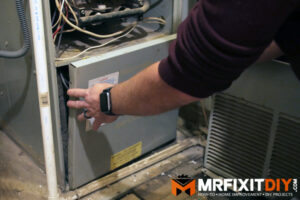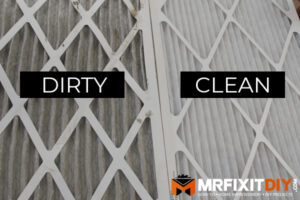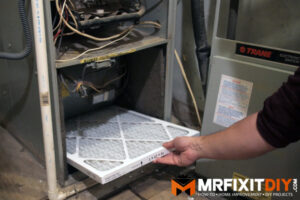Let’s be honest, when is the last time you changed the air filters on your home’s heating and cooling system(s)? Has it been 6 months? Years? Did you even know that was something you should be doing? Well I can assure you that not only is it something you SHOULD be doing, but it’s something you should be doing regularly. Like every 3-6 months depending on usage and the area you live in! With it being the New Year, now is the time to start a new healthy habit for your home by making 2020 the year you vow to change your filters regularly.
Disclosure: This article contains a paid product integration by Trane Residential. All views and opinions expressed herein are my own.
Why Change Your Filters?
Your home breathes just like we do. Dust, smoke, dirt, mold, fumes, and other elements from the outside are brought in every time you open a door or window and even with changes in pressure systems due to weather events. These things end up in the air in your home and it’s the responsibility of your heating & cooling system to circulate, collect, and filter these particles out of the air and deliver you clean, temperature controlled air back to keep your home both comfortable and clean.
In order for your heating and cooling systems to work properly, they need to be able to pull air in. A filter that is old and dirty is like going for a jog with a plastic bag over your head with only a tiny pinhole poked in it! Not only is your body going to have to work harder to try and keep you going, but you’re also probably not going to make it very far before you collapse due to asphyxiation. Your home’s heating and cooling system is no different. When the filter is plugged or dirty, it has to work harder to do its job. With prolonged neglect, the components will overheat, wear out, or fail entirely which can lead to thousands of dollars in repairs or replacements.
Fortunately changing the air filters in your home is typically one of the simplest (and most inexpensive) DIY jobs a homeowner can do. It usually requires very few (if any) tools so even the most inexperienced people can do it.
How to Locate Your Filter
Depending on your home’s heating and cooling system, you may have one or several filters. Typically a home that has a single furnace/cooling system only has one filter while a larger home that has multiple heating/cooling zones may have more than one. In either case, locating your furnace is usually a good place to start. Check your utility closet, or basement to find your system. The filter on your furnace may be attached to the side in an enclosure, or it may be inside the unit under a cover. If so, turn the power off to the furnace before changing the filter to avoid damaging any components.
 If you have a roof mounted or attic based system, the filter may also be mounted to the ceiling in a hallway or living area under a grate. In all cases, the filter is on the air intake/return of your HVAC system as it filters the air that is pulled into the system.
If you have a roof mounted or attic based system, the filter may also be mounted to the ceiling in a hallway or living area under a grate. In all cases, the filter is on the air intake/return of your HVAC system as it filters the air that is pulled into the system.
Changing Your Filter(s)
Once you’ve located your HVAC system and filter, all that’s left to do is change the filter!
Step #1: Remove the Cover Grate
 Overhead filters usually have a grate door which can swing down to access the filter, while furnace filters may be under the unit or beside it. Some filters may be held in with a wire or retaining clip.
Overhead filters usually have a grate door which can swing down to access the filter, while furnace filters may be under the unit or beside it. Some filters may be held in with a wire or retaining clip.
Step #2: Remove the Dirty Filter
 You know a filter is in need of replacement if you have trouble seeing light through it, or it is visibly dirty. When in doubt, it doesn’t hurt to replace it especially if it’s been more than 6 months since it was last changed.
You know a filter is in need of replacement if you have trouble seeing light through it, or it is visibly dirty. When in doubt, it doesn’t hurt to replace it especially if it’s been more than 6 months since it was last changed.
Step #3: Make Sure You Buy the Proper Size Replacement
 Knowing the size of the air filter you are replacing is important to make sure you are replacing it with the proper sized replacement. The size of your filter is listed on the filter itself typically as a 3 number combination (e.g. 16 x 25 x 1) When shopping for a replacement filter, you will need these numbers to buy the correct replacement.
Knowing the size of the air filter you are replacing is important to make sure you are replacing it with the proper sized replacement. The size of your filter is listed on the filter itself typically as a 3 number combination (e.g. 16 x 25 x 1) When shopping for a replacement filter, you will need these numbers to buy the correct replacement.
For replacement filters, I recommend you use the new Trane Comfort Performance Filters which you can find at Walmart.com. Trane has been a leading manufacturer of HVAC systems for decades and their new Comfort Performance filters are compatible with virtually all HVAC systems.
Step #4: Replace Your Air Filter
 Before re-installing your filter, it’s a good idea to place the date on the side of the filter so you have a reference for when it was last changed next time you check it. It’s also not a bad idea to set yourself a reminder on your calendar to change it again in 3-6 months.
Before re-installing your filter, it’s a good idea to place the date on the side of the filter so you have a reference for when it was last changed next time you check it. It’s also not a bad idea to set yourself a reminder on your calendar to change it again in 3-6 months.
Reinstall your new air filter (paying attention to the arrow on the side that indicates air flow direction), re-attach any retaining wires or clips, and close any grates or doors that you previously opened to access the filter. Also be sure to remember to turn the power back on to the furnace or system if you turned it off.

So that’s it for this project! It’s a simple periodic maintenance task you should add to your to-do list to keep your home’s HVAC system in good shape. It’s inexpensive, and will keep your system running properly for years if you keep up with it. Much like your car, regular preventative maintenance goes a long way towards keeping your home in good working order.
Thanks for reading this article. If you enjoyed it, here are some other projects you might also enjoy. See you next time!
5 DIY Ways to Make Your Home More Energy Efficient
10 Ways to Warm Your Home and LOWER Your Energy Bill
How to Monitor Your Homes Energy Usage











[…] If I sound like a broken record about this it’s because it’s one of the simplest and beneficial things you can do for your heating & air conditioning system. So many potentially problematic issues can be avoiding if you just change your filters out regularly. (Every 3 months if you can) For more info on the benefits of changing your filters regularly, check out this previous article I wrote. […]
Comments are closed.